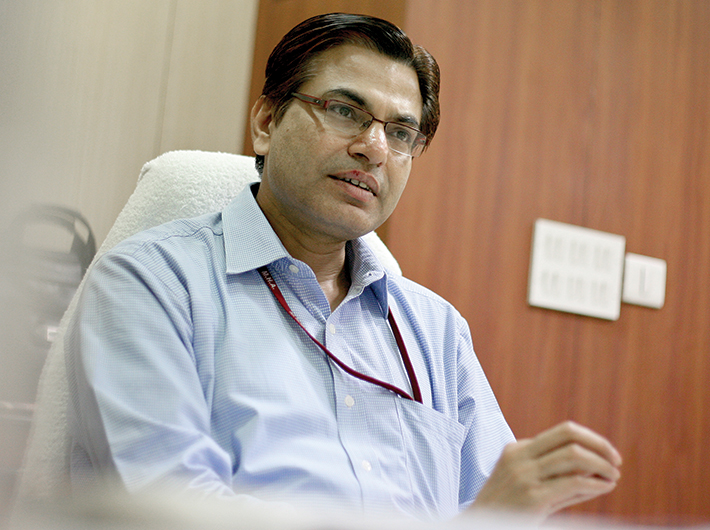In conversation with Dr Rajendra Kumar, joint secretary (e-governance), department of electronics and information technology (DeitY) on milestones covered by NeGP in its seventh year and the challenges ahead
Dr Rajendra Kumar is a 1992 batch IAS officer of the Tamil Nadu cadre. He holds a BTech from the Indian Institute of Technology, Kanpur, and a PhD from Massachusetts Institute of Technology (MIT). He has played a key role in creating a framework on mobile governance. In his current position as joint secretary, e-governance, department of electronics and information technology (DeitY), he is overseeing the migration of the national e-governance plan (NeGP) to the next phase.
Edited excerpts of the interview:
Out of the total outlay of '46,000 crore for the NeGP, how much has been spent? Can we have the break-up of the spending? A major portion of this has gone into funding state mission mode projects (MMPs), but these are also the worst performers in terms of implementation.
The NeGP has done remarkably well in its implementation. Out of the 27 MMPs approved as part of the NeGP originally, 23 have started delivering services to the citizens and other stakeholders. The MMPs are conceptualised, designed and implemented by the respective ministries and departments. Details of expenditure on the individual MMPs are not collected by DeitY on a regular basis.
The performance with regard to state MMPs has been varied. While many states have done well, others are at different stages of implementation. Our efforts have been to bring all the states on similar performance levels – on a par with the leading states – with regard to the implementation of the MMPs.
DeitY provides support to all ministries and departments in formulating and implementing MMPs under the NeGP. This includes technical advice, formulation of standards and guidelines and provision of core ICT infrastructure and middleware, such as state wide area network (SWAN), state data centre (SDC), common services centre (CSC), national service delivery gateway (NSDG) and state service delivery gateway (SSDG). However, the actual implementation of MMPs is the responsibility of the ministry and department concerned. The achievement of the milestones in implementation and utilisation of the funds also comes within the purview of the ministry and department concerned.
Has DeitY assessed the utilisation of information infrastructure created under NeGP by government agencies – whether MMPs are hosted in state data centres, whether states are hosting applications on SWANs?
DeitY has been working with all the states to ensure that the core ICT infrastructure created under the NeGP is utilised optimally across all the states. The utilisation of SDCs and SWANs has improved very significantly in the states where they have been operational for more than a year. The states where they have become operational recently are also catching up quickly. We have set a target of 50 percent utilisation of rack space in SDCs and 60 percent utilisation of bandwidth for SWANs initially for all the states. Several states have already exceeded these milestones.
Can you tell us which states qualify on these parameters – 50 percent utilisation of rack space in SDCs and 60 percent utilisation of bandwidth for SWANs?
SWAN has been implemented in 31 states (and UTs) and SDC has been implemented in 21 states. Twelve states have achieved 50 percent utilisation of rack space in SDCs and 14 states are utilising 60 percent of bandwidth for SWANs. Six states have both 60 percent bandwidth utilisation and are also using more than 50 percent of the available SDC rack space. They are Manipur, Tripura, West Bengal, Tamil Nadu, Andhra Pradesh and Haryana.
Where are we moving with the CSC project? There is hardly any government-to-citizen (G2C) service available at these centres. Even awareness in line departments is extremely low. Why have we not seen line departments and ministries using telecentres for delivering services?
In terms of establishing and operationalising CSCs, the overall performance has been quite satisfactory. Several states have also done well in providing G2C services. In several states, other line departments have started using CSCs for delivering their services. With the national roll-out of the e-District project in all the states covering all the districts, we expect that a large number of G2C services would become available for delivery through CSCs. This will help in making the CSCs more viable and sustainable.
DeitY had also planned to deliver telemedicine and tele-education through CSCs. Has it really started anywhere?
Telemedicine and tele-education services have been provided as pilot projects in several states. For example, in Tamil Nadu, telemedicine services are being delivered through CSCs in Dharmapuri district. The project was launched with the full support of the state government and the government hospitals in the districts were involved in delivering the services. Several CSCs are offering computer learning courses online to the students and educated youth in their villages.
Are MSAs under CSC project being renewed?
This issue comes under the purview of the state governments and they are fully empowered to take necessary action in this regard.
What is the idea behind coming up with national information infrastructure (NII)? Can this be called NeGP 2.0?
The NII is being conceptualised as an integrated ICT infrastructure that would enable provision of network infrastructure for government departments and agencies up to the panchayat level and cloud-based infrastructure for provisioning of cloud-based services. It aims at consolidating the existing network and data centre infrastructure and providing the next generation infrastructure that will cater to the needs of government departments and agencies in the coming years. It will aim at harmonising various infrastructure assets while leveraging the latest available technologies and concepts like cloud computing, IaaS, PaaS etc. NeGP 2.0 is in the very initial stages of conceptualisation.
Can you share your experience about the pilot project on e-office in DeitY? Can you explain the benefits of e-office in terms of bringing transparency, accountability and record keeping in the government and how it would impact the decision making in the government? While we know that the project is being implemented by DARPG, could you please comment on the delay in its implementation?
The e-office suite is being implemented in DeitY in various divisions. In the e-governance division within the department, all the files have been migrated to e-office.
The e-office as an MMP is being implemented by DARPG in various ministries and departments.
Deity often talks about appointing chief information officers (CIOs) in line ministries. But it hasn’t happened. There are instances like Andhra Pradesh where the state government’s CIO programme has not yielded results, as the trained officials were never given the right positions. Do you plan to sort this out?
DeitY has been conducting CIO training programmes to groom the talented officials and professionals within the government to assume this important leadership position. Our hope is that the trained persons would be retained and given appropriate responsibilities in the ICT and e-governance domain. In several cases, the trained officials have been retained in the e-governance domain and have also been given appropriate responsibilities. The departments concerned have realised this aspect and we expect that their response would be even better in future in this regard.
Why is there no interoperability framework even after seven years of NeGP?
DeitY has published guidelines and standards on the interoperability framework. [See: http://egovstandards.gov.in/review-documents/public-review/ifeg-ii/IFEG_Phase-II.pdf.] The applications developed recently have followed this framework. The legacy applications need to implement these guidelines to achieve full interoperability.
Can you talk about the citizen engagement framework?
DeitY notified the citizen engagement framework for e-governance projects in August 2012. There is a need for wider and deeper engagement with all the stakeholders, especially the people, in all the e-governance projects being implemented across the country. The citizen engagement framework addresses this issue with a view to ensure that citizen centricity is maintained in all the e-governance projects in the country. The framework is meant for all the government departments and agencies implementing these projects.
What is the cloud framework which DeitY is working on? What does it mean for states and citizens? Can you give us some examples of infrastructure as a service (IaaS) and software as a service (SaaS) in the public sector?
The main objective of the cloud framework that DeitY has been working on is to ensure a systematic approach towards adoption of cloud-based technologies in e-governance projects in the country. The report of the working group formed for this purpose is being finalised now. There is another working group that has been formed to suggest a road map for development of cloud capabilities and their adoption within the industry in India. The cloud platform for the government will encompass the full range of services that can be delivered through it, including IaaS, PaaS and SaaS.
Can you comment on the electronic delivery of services (EDS) bill? What will be its impact?
The EDS bill is aimed at ensuring that all government departments offer their services electronically to the citizens. The bill has been finalised after extensive consultations with all the stakeholders. We hope that the bill would become a reality soon.
Can you tell us about service delivery using the mobile platform?
Mobile governance is an important part of the overall vision of reaching out to all citizens in the country for delivering government services electronically. As the penetration of mobile phones is much more compared to the access to internet in our country, mobile platform can really help in widening the access and reach of electronic services tremendously, especially in rural areas.
DeitY has already notified the framework for mobile governance in February 2012 and a mobile service delivery gateway (MSDG) has been created to help the government departments and agencies in delivering their services through the mobile platform. Already, the mobile SMS Gateway offering ‘push’ and ‘pull’ services and a Mobile AppStore are operational. USSD- and IVRS-based services are at pilot stage. Currently, 365 departments across the country are using MSDG to offer their mobile-based services. Over 100 mobile applications have also been made live on the Mobile AppStore.
The applications can be downloaded and installed even on low-cost mobile phones and tablets running on the open source Android operating system. The number of transactions being delivered through MSDG has crossed ten lakh per day. The details of the entire project can be seen at: mgov.gov.in.
Can you tell us how many service centre agencies (SCAs) have been blacklisted and what is the amount that has to be recovered from them?
Action against SCAs for any violations or breaches of the contract and terms and conditions comes within the purview of the state governments concerned.
Since simplifying service delivery was the major concern for automation of departments and their inclusion as MMP under NeGP, there are a number of ministries/departments which have not been included; for example, labour, social welfare, planning commission, PMO and cabinet secretariat. Is there any thought to automate the workflow and record keeping of these departments?
Though many departments have not been included under the NeGP, most of them have implemented e-governance projects on their own and are providing services electronically to the citizens and other stakeholders. The proposed electronic delivery of services (EDS) bill seeks to make it mandatory for all departments to provide their services electronically within a specified timeframe. This will help the departments in implementing integrated e-governance projects with the required business process re-engineering and automation of the workflows.

